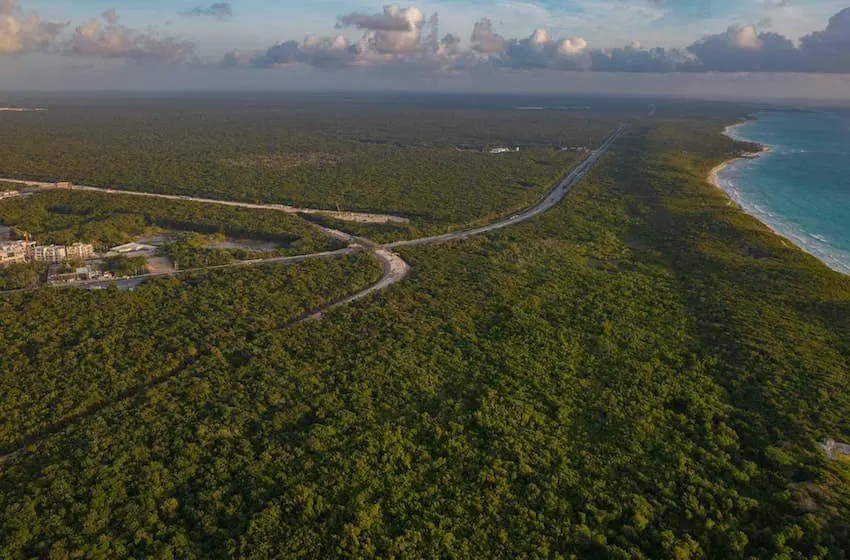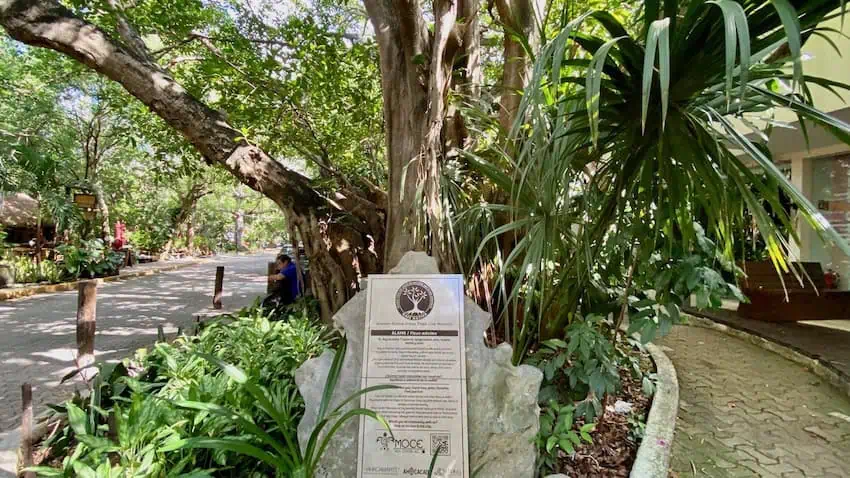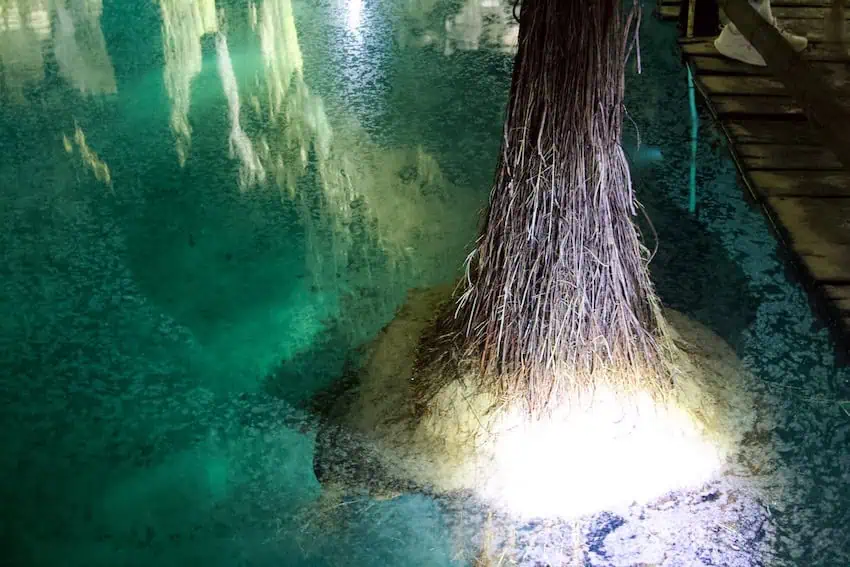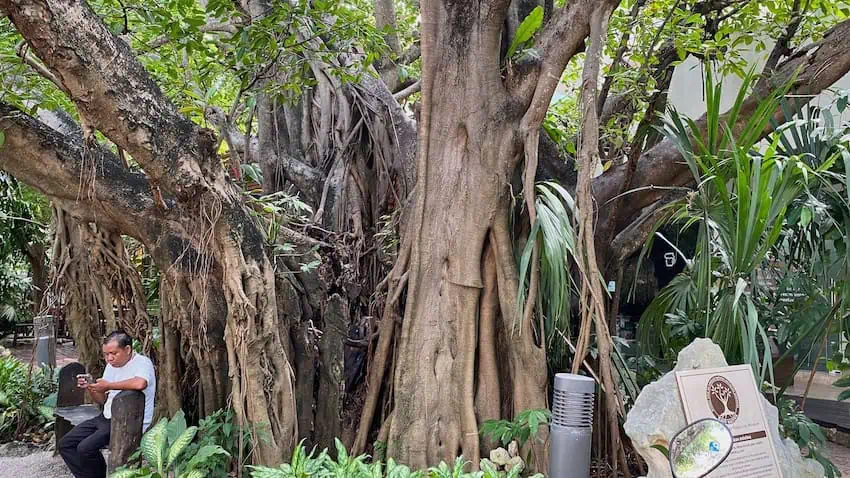One of my all-time favorite things is stumbling upon something amazing without even trying. You know what I mean? When you turn a corner and — bam — there’s something incredible, and you think, “How did I not know about this?”
Like a tropical fruit that tastes like cheese. Or a walking tree.

It might sound unbelievable, but the second discovery happened to me during my last visit to Playa del Carmen. I’ve visited Playa countless times over the past eight years, living on Cozumel, since that’s where the ferry from the island docks. After so many visits, I didn’t think there were any more surprises left.
I was wrong.
Walking down leafy Calle 38 toward the beach, a giant tree stopped me in my tracks. Its canopy stretched over the road and the restaurants on either side, leaving me gobsmacked. My first thought was, “The Tule Tree in Oaxaca had a baby.”
The Álamo in Playa del Carmen, Mexico’s walking tree

Álamo, a giant Mexican fig tree, as described on the plaque, is a type of fig tree native to Mexico, Ficus maxima. Maxima is right! While it’s not Mexico’s largest tree, it is the country’s largest fig tree. Why is that noteworthy? Because it’s a natural wonder. To my nature-loving heart, that’s pretty awesome.
Like all botanical enthusiasts, I’m thrilled when a massive tree, a beautiful flower, or some exotic plant catches me off guard. The kind of thrilled that leaves me standing in the street so long that people ask if I’m okay. In fact, one friendly local sitting under the tree did ask if I was lost and offered to help — another reason to love Mexican people.
He pointed to a plaque on the sidewalk, providing more information. It read: “I am an Álamo, an old and native barbel tree that likes to walk.”
How does the Álamo walk?
My second favorite discovery, after the tree itself, was learning that it walks. Yes, you read that correctly.
This type of Mexican fig tree, known as a barbel, has aerial roots that grow thick and long toward the ground. When they reach the ground, they become columns, called legs or buttresses. Over time, as one leg dries, another forms, literally taking the next step. This process allows the tree to slowly “walk” across the forest.
Indigenous people call this tree “Kopo” or “Sacahua.” They believe where it grows, a cenote is nearby. I can believe it. My friend and I walked through a five-million-year-old cave last month, and thick tree roots hung from the ceiling, reaching into the cenote’s water below.
A living museum of trees

Another fascinating fact on the plaque: This Álamo is part of a living museum of ancient trees called the Ancient Native Urban Tree Live Museum, an initiative by MOCE Yax Cuxtal. It aims to preserve the largest old trees in Playa del Carmen, including this Álamo and other species.
Development and urban sprawl often lead to the destruction of these ancient trees — hundreds of years of growth felled in minutes. This living museum educates people about the native trees of the region, their environmental impact, and the unique micro-environments they create.
As the plaque says, “I am a tree. And like you, I have legs, arms, I breathe, I feel, and I live.”
A world in a tree
Spending time with the Álamo revealed a world around me. Squirrels chattered, climbed, and ran along its sprawling branches, making nests in the trunk’s nooks and crannies. As dusk approached, butterflies, bugs, and bats emerged. I counted seven bird species in just ten minutes, all visiting, feeding, or roosting in the branches.
An entire ecosystem in ten minutes. Isn’t it amazing what you can see when you slow down and observe a tree? Especially one in a bustling tourist area near the beach in Playa del Carmen. Figs are considered a keystone species for fruit-eating animals, providing reliable food during scarce times like droughts.
It’s no wonder an entire world exists in a walking tree — it almost feels like an analogy for Mexico itself.
The most amazing relationship of all

Did you know figs are pollinated exclusively by wasps? Each fig tree has a mutualistic relationship with a specific wasp species, meaning they can only reproduce within that tree’s figs.
This blew my mind almost as much as learning that figs have enclosed flowers. There’s a tiny hole for the wasp to wriggle through to pollinate the hundreds of tiny flowers inside as the female wasp lays her eggs.
I had to rack my brain to remember if I’d ever seen a fig flower. But for me, the micro-environment this tree creates is as amazing as the fact that it walks. What an incredible discovery to make without even trying.
Walking trees — just another incredible day in Mexico!
Mexico Correspondent for International Living, Bel is an experienced writer, author, photographer and videographer with 500+ articles published both in print and across digital platforms. Living in the Mexican Caribbean for over 7 years now she’s in love with Mexico and has no plans to go anywhere anytime soon.
